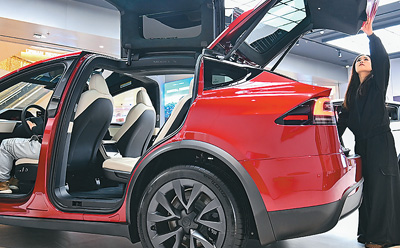China's new consumption trends in keywords
China's huge consumer market, which witnessed new highlights and changes, is thriving with the development of new technologies, new models, and new business forms.
In the first 11 months of 2024, the country's total retail sales of consumer goods exceeded 44 trillion yuan (about $6.03 trillion), up 3.5 percent year on year. The following keywords highlight China's new consumption trends.
Trade-in of consumer goods
This year, thanks to policy-backed trade-in programs, many consumers in China have purchased "big-ticket" items such as new energy vehicles, smart and eco-friendly home appliances, and electronic products, enjoying tangible benefits.

A citizen visits a car dealer shop in a mall in southwest China's Chongqing Municipality. (Photo/Sun Kaifang)
Since the beginning of this year, the sales revenue of consumer goods under China's policy-backed trade-in program has surpassed 1 trillion yuan, data from China's Ministry of Commerce showed. As of Dec. 13, the 2024 sales volume of passenger vehicles under the trade-in program had exceeded 5.2 million units, and sales of home appliances had surpassed 49 million units, with sales of electric bicycles approaching 900,000 units.
First stores and launch events
International brand Chanel held a global launch event by West Lake in Hangzhou, east China's Zhejiang Province. Nearly 100 international brands have opened their first stores in Asia or China in Shanghai's Zhang Yuan, or Zhang's Garden. A batch of flagship stores and innovative concept stores are continuing to enrich the commercial landscape in Beijing.

Photo shows the New World Daimaru Department Store in Shanghai. (Photo/Wang Chu)
The "first launch economy" has become a key catalyst for regional commercial growth, with the rise of "first stores" and other innovative consumption scenarios attracting visitors seeking entertainment, leisure, and relaxation.
Between January and July 2024, Shanghai saw the opening of 770 new first stores, a year-on-year increase of 16.5 percent, including five first stores globally, four in Asia, and over 100 in China. According to data from the Beijing Municipal Commerce Bureau, in the first three quarters of this year, 717 first stores, flagship stores and innovative concept stores were opened in the capital city, showing a remarkable 40 percent year-on-year growth.
Tourism boom
China's cultural and tourism market has been booming this year. Inbound tourism is thriving. The introduction of the 144-hour visa-free transit policy, later extended to 240 hours, and the expansion of the coverage of visa-free countries have continuously enhanced China's openness to the world, making "China Travel" a hot topic on social media both at home and abroad. In the first nine months of this year, China welcomed about 95 million inbound arrivals, surging nearly 80 percent from the same period last year.

Meanwhile, domestic tourism is flourishing. The integration of various cultural, commercial, and travel business forms has deepened, with sports-themed tourism and food tours gaining momentum. The search volume for ice and snow tourism activities such as skiing and ice skating has more than doubled since November, according to data from service-focused e-commerce giant Meituan.
County-level economy
The county-level economy has great potential, as China's county-level administrative regions, numbering over 2,800, account for nearly 40 percent of the national economy.
Many well-known chains have opened stores in county-level regions, driving the quality upgrade of county-level consumer market. Data from Meituan showed that the online coffee delivery orders of brands like Starbucks, Luckin Coffee, and Cotti Coffee in county seats skyrocketed by 97 percent year on year in 2024, while the number of online delivery merchants grew by 159 percent.
In addition, the county-level tourism has been popular this year, boosting local consumption in sectors of dining, traveling, entertainment, and shopping.
Silver-hair market
The development of the silver hair economy has brought to light the significant consumption potential of the "young old" group, characterized by both strong purchasing power and diverse consumer preferences.

A senior woman tries her hands on a recreational musical instrument at the 2024 Shenzhen International Intelligent Elderly Care Industry Expo in Shenzhen, south China's Guangdong Province. (Xinhua/Liang Xu)
There is a large base of the "young old" in China. Their consumption is expanding into various fields such as fitness, cosmetics, healthcare, and tourism.
According to a 2024 report on silver-haired consumers issued by China's leading retailer JD.com, the transaction volume of elderly-friendly products of shower chairs and multifunctional electric beds surged by 202 percent and 152 percent year on year, respectively.
As of the end of 2023, the population of elderly individuals aged 60 and above in China had reached 297 million, accounting for 21.1 percent of the country's total population. The sector of elderly care encompasses a wide range of services and industries, enjoying immense potential for growth and development.
China-chic
There has been a notable increase in the incorporation of Chinese traditional cultural elements into everyday life this year. This China-chic trend is evident in the growing interest in purchasing Chinese-style cultural and creative products, the innovative reinterpretation of traditional Chinese fashion, the experience of intangible cultural heritage, and the fascination with ancient cities and towns.
A report indicated that with the increasing influence of traditional culture on consumer trends, concepts such as China-chic and neo-Chinese style have permeated various consumer sectors and scenes, including catering, entertainment, culture and tourism, beauty, and fashion.
Emotional consumption
A growing number of consumers are willing to pay for emotional satisfaction. According to a 2023 report issued by the China Consumers Association, emotional value becomes a crucial factor influencing young consumers' purchasing decisions.
Meituan data showed that the search volume for "emotional healing" products has surged 280 percent year on year since the beginning of 2024, with more than 1,000 new relevant products launched monthly on the platform.
Cross-industry collaborations
The retail landscape has witnessed innovative business model combinations, such as supermarket-restaurant hybrids. Several Chinese supermarket brands like Yonghui, Wumart, and Hualian have integrated dining halls into their supermarkets, leveraging their supply chain advantages while boosting customer flows.
Similar cross-industry experiments include paid cooking services at wet markets, "hotpot + KTV," and various other collaborations that cater to evolving consumer preferences while conforming to the new trend of transformation of brick-and-mortar stores.
Photos
Related Stories
- Foreign-invested firms benefit from China's trade-in program
- Targeted measures to boost consumption
- Chinese buyers are open-minded when shopping for goods, home-made or imported
- Firms in high gear for year-end sales
- Seven ministries launch joint plan to drive retail industry upgrade amid efforts to boost consumption
- Nation intensifies efforts to boost consumption as trade-in policies strengthen market impact
- China's trade-in program boosts consumer goods sales by over 1 trillion yuan
- China’s Double 12 shopping festival set to boost consumption with trade-in policies
- Trade-in program continues to boost consumption with 5 million applications for autos
- China refines duty-free, tax refund policies for better consumption experience
Copyright © 2024 People's Daily Online. All Rights Reserved.









